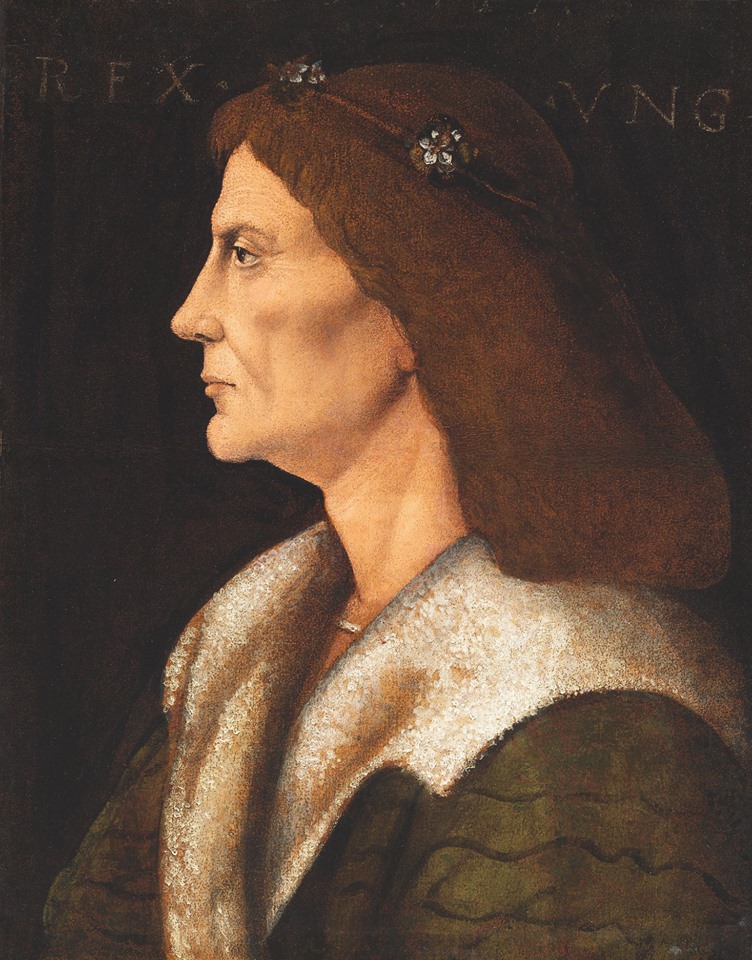It was through Matthias Corvinus (1443–1490), who became King of Hungary aged 15 in 1458, that Renaissance art and Humanism was first exported outside Italy. The King’s erudition and interests linked him closely with Lorenzo il Magnifico in Florence, and they exchanged letters about their progress in forming their libraries. Many of the very beautiful volumes (often similar in size and decoration) that they commissioned in Florence from Renaissance artists and scholars have survived. By the end of his life Corvinus possessed one of the most important libraries then in existence—and, far richer than his Medici counterpart, he was able to put together an even more precious collection of manuscripts than the one then in Florence. Some of the manuscripts (including his Bible, exquisitely illuminated in Florence by Attavante and Gherardo and Monte di Giovanni) remained unfinished at his death so never reached Hungary, but are today preserved in the Medici Biblioteca Laurenziana in Florence.

In 1476 Corvinus married Beatrice, the highly educated daughter of Ferdinand I of Aragon, King of Naples, and he had a splendid marble bust of her made by Francesco Laurana at the time of their engagement. She was only 16 or 17 years old and Laurana’s sculpture is today one of the masterpieces in the Frick Museum in New York. The couple were then portrayed, probably by Giovanni Dalmata, in a double portrait (preserved in Budapest) in profile in low relief in white marble against a dark green background. Beatrice proved a worthy wife, sharing Matthias’s passion for books and music and she herself was a patron of the arts. Also preserved in Budapest is the splendid brocaded velvet which once decorated the royal throne in Buda, known to have been made in Florence on a design by Antonio del Pollaiolo (and restored in 2013).
It was at the court of Matthias’s predecessor King Sigismund that Filippo Scolari, known as Pippo Spano, had an important career as military leader but he was also a renowned Humanist. At that time the painter Masolino was called to Hungary to carry out frescoes for his funerary chapel, so the artist abandoned his work at the Brancacci Chapel in Florence, leaving Masaccio to complete it. Pippo Spano was immortalised in Florence as one of the ‘famous men’ frescoed by Andrea del Castagno (now in the Galleria degli Uffizi, but sadly usually not on view).
During Matthias’s time many Florentine merchants lived in Buda, including Bernardo Vespucci, brother of Amerigo. We know that in 1469 the Signoria sent two lions, symbols of Florence, to Corvinus, as a sign of homage.
A portrait of Matthias, with his characteristic long flowing locks, by an unknown Lombard painter copied from a famous portrait of him by Mantegna (now lost) has had an interesting history. When attributed to Boltraffio, it was purchased from a private Italian collection by the press baron Lord Rothermere, famous as an advocate of the revision of the Versailles Peace Treaty. In certain influential political circles in Hungary at the time Rothermere became so popular for the irredentist campaign in his popular newspapers that a proposal was made to him to become Hungarian head of state (or, if he preferred, to have his son thus enthroned). This clearly caused him considerable embarrassment and to avoid any misunderstanding he presented this portrait of Matthias to Miklós Horthy in 1930, on the tenth anniversary of the latter’s election as regent of the Hungarian state, and it was hung in the royal palace of Buda. It is now in the Szépművészeti Múzeum in Budapest, but in store and so sadly not on view.
At the end of last year Italy dedicated its first exhibition to Matthias Corvinus, appropriately held in the library of San Marco, and curated by Péter Farbaky, director of the Budapest History Museum. Farbaky’s interest in Corvinus had already led to an international conference in Florence at Villa I Tatti in 2007, the papers of which where published in November 2011 by Harvard University.
(by Alta Macadam, author of Blue Guide Florence.)
In March of this year, also in the Budapest History Museum, an exhibition will open of self-portaits of Hungarian artists from the Uffizi collection. The show will be reviewed on this blog.






